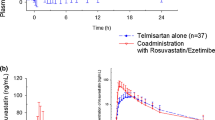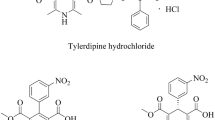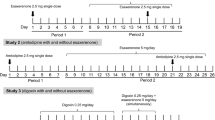Abstract
Background and Objective
Combination therapy is recommended for the effective management of hypertension according to most treatment guidelines, including those of the US Joint National Committee. Therefore, pharmacokinetic drug interactions are an important issue in combination therapy for hypertension. In this study, the pharmacokinetic properties of telmisartan and chlorthalidone were evaluated to investigate their pharmacokinetic interactions in healthy subjects.
Methods
Two separate, randomized, multiple-dose, two-period, one-sequence studies were conducted. In study A, 43 participants received 80 mg of telmisartan orally for 7 days, and were then administered oral chlorthalidone 25 mg for 14 days (days 8–21), coadministered with 80 mg of telmisartan from day 15. In study B, 14 participants received oral chlorthalidone (25 mg) for 13 days, followed by coadministration with 80 mg of telmisartan orally for 7 days.
Results
The geometric mean ratios (GMRs) (90 % confidence intervals [CIs]) of the maximum plasma concentration (C max,ss) and area under the concentration-time curve for the dosing interval at steady state (AUCτ,ss) of telmisartan (with and without chlorthalidone) were 1.018 (0.861–1.203) and 1.099 (1.015–1.190), respectively. For chlorthalidone (with/without telmisartan), the GMRs (90 % CIs) for C max,ss and AUCτ,ss were 0.996 (0.922–1.075) and 0.992 (0.925–1.064), respectively. The GMRs and 90 % CIs for telmisartan and chlorthalidone were all within the 0.80–1.25 range.
Conclusion
Thus, in this study, there was no significant pharmacokinetic interaction between telmisartan and chlorthalidone.
ClinicalTrial.gov identifier
NCT01806363.



Similar content being viewed by others
References
Maillard MP, Burnier M. Is the fixed-dose combination of telmisartan and hydrochlorothiazide a good approach to treat hypertension? Vascular Health Risk Manage. 2007;3(3):265–78.
Keating GM. Losartan/hydrochlorothiazide: a review of its use in the treatment of hypertension and for stroke risk reduction in patients with hypertension and left ventricular hypertrophy. Drugs. 2009;69(9):1239–65.
Sharpe M, Jarvis B, Goa KL. Telmisartan: a review of its use in hypertension. Drugs. 2001;61(10):1501–29.
Karlberg BE, Lins L-E, Hermansson K. Efficacy and safety of telmisartan, a selective AT1 receptor antagonist, compared with enalapril in elderly patients with primary hypertension. J Hypertension. 1999;17:293–302.
Freytag F, Schelling A, Meinicke T, Deichsel G, for the Telmisartan Hypertension Experience in a Randomized European Study Versus Atenolol Study Group. Comparison of 26-week efficacy and tolerability of telmisartan and atenolol, in combination with hydrochlorothiazide as required, in the treatment of mild to moderate hypertension: a randomized, multicenter study. Clin Ther. 2001;23(1):108–23.
Stangier J, Su C, Roth W. Pharmacokinetics of orally and intravenously administered telmisartan in healthy young and elderly volunteers and in hypertensive patients. J Int Med Res. 2000;28:149–67.
Tatami S, Sarashina A, Yamamura N, et al. Population pharmacokinetics of an angiotensin II receptor antagonist, telmisartan, in healthy volunteers and hypertensive patients. Drug Metab Pharmacokinet. 2003;18(3):203–11.
Stangier J, Su CA, Hendricks MG, et al. The effect of telmisartan on the steady-state pharmacokinetics of digoxin in healthy male volunteers. J Clin Pharmacol 2000;40(12 Pt1):1373–9.
Israili ZH. Clinical pharmacokinetics of angiotensin II (AT1) receptor blockers in hypertension. J Hum Hypertens (Suppl). 2000;14:S73–86.
Unger T, Kaschina E. Drug interactions with angiotensin receptor blockers: a comparison with other antihypertensives. Drug Saf. 2003;26(10):707–20.
Mallat SG. What is a preferred angiotensin II receptor blocker-based combination therapy for blood pressure control in hypertensive patients with diabetic and non-diabetic renal impairment? Cardiovasc Diabetol. 2012;10(11):32.
Gradman AH. Rationale for triple-combination therapy for management of high blood pressure. J Clin Hypertens. 2010;12(11):869–78.
Carter BL, Ernst ME, Cohen JD. Hydrochlorothiazide versus chlorthalidone: evidence supporting their interchangeability. Hypertension. 2003;43:4–9.
Sica DA, Carter B, Cushman W. Thiazide and loop diuretics. J Clin Hypertens. 2011;13(9):639–43.
Sica DA. Chlorthalidone: a renaissance in use? Exp Opin Pharmacother. 2009;10(13):2037–9.
Sica D, Bakris GL, White WB, et al. Blood pressure-lowering efficacy of the fixed-dose combination of azilsartan medoxomil and chlorthalidone: a factorial study. J Clin Hypertens. 2012;14(5):284–92.
Cheng JW. Azilsartan/chlorthalidone combination therapy for blood pressure control. Integr Blood Press Control. 2013;6:39–48.
James PA, Oparil S, Carter BL, et al. 2014 evidence-based guideline for the management of high blood pressure in adults: report from the panel members appointed to the Eighth Joint National Committee (JNC 8). J Am Med Assoc. 2014;311(5):507–20.
World Medical Association. World Medical Association Declaration of Helsinki ethical principles for medical research involving human subjects. J Am Med Assoc. 2013;310(20):2191–4.
ICH harmonised tripartite guideline: guideline for good clinical practice E6 (R1). International Conference on Harmonisation of technical requirements for registration of pharmaceuticals for human use. 1996. Available at: http://www.ich.org/products/guidelines/efficacy/article/efficacy-guidelines.html. Accessed 12 Apr 2016.
Guideline for the validation of bioanalytical method. Ministry of Food and Drug Safety. Republic of Korea, 2010. Available at: http://www.mfds.go.kr/index.do?mid=689&pageNo=46&seq=7560&cmd=v. Accessed 15 Nov 2015.
Guidance for industry: Drug interaction studies: study design, data analysis, implications for dosing, and labeling recommendations [draft guidance]. FDA Center for Drug Evaluation and Research. Silver Spring, MD: FDA, 2012. Available at: http://www.fda.gov/drugs/GuidanceComplianceRegulatoryInformation/guidances/default.htm. Accessed 15 Nov 2015.
Wagstaff AJ. Valsartan/hydrochlorothiazide: a review of its use in the management of hypertension. Drugs. 2006;66(14):1881–901.
McCrea JB, Lo MW, Tomasko L, et al. Absence of a pharmacokinetic interaction between losartan and hydrochlorothiazide. J Clin Pharmacol. 1995;35(12):1200–6.
McGill JB, Reilly PA. Telmisartan plus hydrochlorthiazide versus telmisartan or hydrochlorothiazide monotherapy in patients with mild to moderate hypertension: a multicenter, randomized, double-blind, placebo-controlled, parallel-group trial. Clin Ther. 2001;23(6):833–50.
Acknowledgment
Drs. S.J. Seong and Ms. Lim contributed equally to this work. This study was supported by a grant of the Korea Health Technology R&D Project through the Korea Health Industry Development Institute, funded by the Ministry of Health and Welfare, Republic of Korea (HI15C0001, HI14C1731, A070001, HI13C1232), the Industrial Core Technology Development Program (10051129, Development of the system for ADME assessment using radiolabeled compounds) funded by the Ministry of Trade, Industry and Energy (MOTIE, Korea), and the Bio and Medical Technology Development Program of the National Research Foundation, funded by the Ministry of Science, ICT and Future Planning, Republic of Korea (NRF-2013M3A9B6046416).
Author information
Authors and Affiliations
Corresponding author
Ethics declarations
Funding
This study was funded by HanAll BioPharma Co., Ltd., Seoul, Republic of Korea.
Conflict of interest
SJS, MSL, JL, BO, MRG, BKK, HJK, DHY, HWL, WYK and YRY have no conflicts of interest that are relevant to the content of this manuscript.
Ethical approval
All procedures performed in studies involving human participants were in accordance with the ethical standards of the institutional and/or national research committee and with the 1964 Helsinki Declaration and its later amendments or comparable ethical standards.
Informed consent
All volunteers received a full explanation regarding the study and submitted a written informed consent before a screening test for eligibility in the study.
Additional information
S. J. Seong and M. Lim equally contributed to this work.
Rights and permissions
About this article
Cite this article
Seong, S.J., Lim, Ms., Lee, J. et al. Evaluation of a Pharmacokinetic Interaction between Telmisartan and Chlorthalidone in Healthy Male Adult Subjects. Clin Drug Investig 36, 613–623 (2016). https://doi.org/10.1007/s40261-016-0406-y
Published:
Issue Date:
DOI: https://doi.org/10.1007/s40261-016-0406-y




